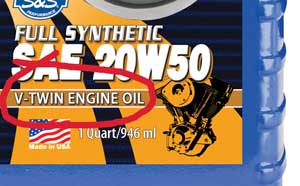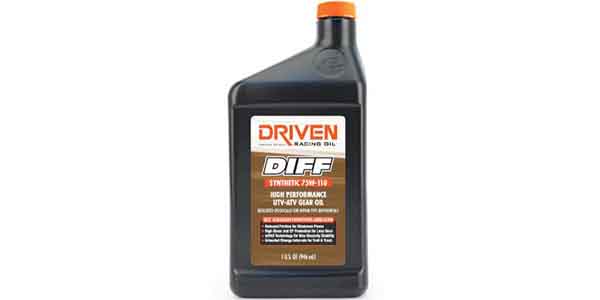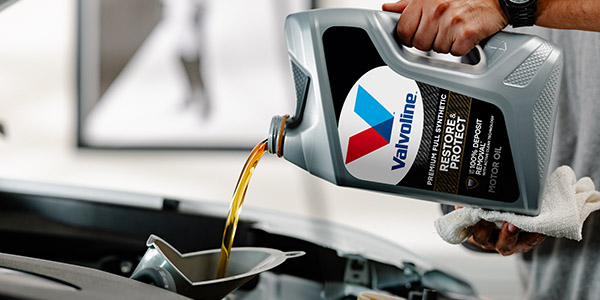 Whenever we get that question on the S&S tech line, we know we’re in for a long conversation. Customers are naturally concerned and want to keep their bikes in peak condition. After all, motorcycles are only fun when they’re running. Of course, there are a lot of misconceptions and bogus information to overcome, so it’s usually a pretty long call.
Whenever we get that question on the S&S tech line, we know we’re in for a long conversation. Customers are naturally concerned and want to keep their bikes in peak condition. After all, motorcycles are only fun when they’re running. Of course, there are a lot of misconceptions and bogus information to overcome, so it’s usually a pretty long call.
The first and most important thing we try to get across is that you should use oil designed for a motorcycle engine. We know it’s tempting to go to a big box store and pick up some automotive oil for short money, but please don’t pour it in your customer’s motorcycle. Rest assured that we’re not just saying that because S&S sells oil. Yes, motorcycle-specific lubricants are more expensive, but there really is a difference.
 Automotive motor oil is subject to stricter environmental regulations than motorcycle oils. There are additives such as zinc and phosphorus that dramatically improve the anti-wear characteristics of a motor oil. These additives are either forbidden or limited to sub-therapeutic levels for cars, but not for motorcycles. Keep in mind that engines in most cars are liquid cooled, which keeps operating temperatures under control way better than the air flowing across the fins of a V-Twin engine. That means that even under normal circumstances, an air-cooled motorcycle engine needs better protection. When things get a little abnormal, a bike engine really needs help. Trailer pulling, racing, or a stop-and-go putt down Lazelle Street on a hot August day can smoke an engine, so make sure you give it the best protection you can.
Automotive motor oil is subject to stricter environmental regulations than motorcycle oils. There are additives such as zinc and phosphorus that dramatically improve the anti-wear characteristics of a motor oil. These additives are either forbidden or limited to sub-therapeutic levels for cars, but not for motorcycles. Keep in mind that engines in most cars are liquid cooled, which keeps operating temperatures under control way better than the air flowing across the fins of a V-Twin engine. That means that even under normal circumstances, an air-cooled motorcycle engine needs better protection. When things get a little abnormal, a bike engine really needs help. Trailer pulling, racing, or a stop-and-go putt down Lazelle Street on a hot August day can smoke an engine, so make sure you give it the best protection you can.
The next question is usually about viscosity. The old timers tend to favor straight weight over multi-viscosity oil because they believe it will do a better job of protecting their engines. The reasoning generally goes something along the lines of “20W50 can’t protect my engine as well as 50 weight because it’s not as thick!” While it’s true that at room temperature, 50 weight certainly is thicker, your engine doesn’t run at room temperature… unless your room is really hot. At operating temperature, 20W50 and 50 weight have the same viscosity.
We are often asked: “How does 20W50 oil “thicken up” to be the same as 50 weight when it gets hot?” It doesn’t. Neither oil gets thicker as it heats up. Fifty weight oil thins out a lot, 20W50 – not so much. They both end up with the same viscosity in a hot engine.
So what’s the advantage? The advantage of the multi-viscosity oil is that since it is thinner when cold, the engine will turn over easier, and the oil flows more quickly, reaching and protecting moving parts sooner on cold start up. Of course, if you live in a really hot climate, you may want a heavier oil than 20W50. That’s why S&S offers 25W60 engine oil. A good idea if your oil temperature consistently runs over 250°F.
Finally, we get to the petroleum vs. synthetic debate, which will probably go on forever. Our position is that either will work fine, but we think synthetic motor oil protects the engine better. It is a fact that not everybody shares our opinion, but here are some other facts to consider. Synthetic engine oil definitely tolerates extreme heat better, maintains viscosity better over time, and does a better job of lubrication. Most of the arguments against synthetic oil are based on cost, and synthetic oil is undoubtedly more expensive.
Here at S&S, we sincerely believe that synthetic engine oil can extend the life of an engine, and is worth the extra cost. However, in view of the controversy, S&S offers both synthetic and petroleum motorcycle engine oils. So no matter which side of the fence you’re on, we can provide products that will take good care of your customer’s engine. Either way, it’s better than using car oil!
Of course, if you do decide to use car oil in your V-Twin, it’s all right. You’ll make the parts suppliers happy!













